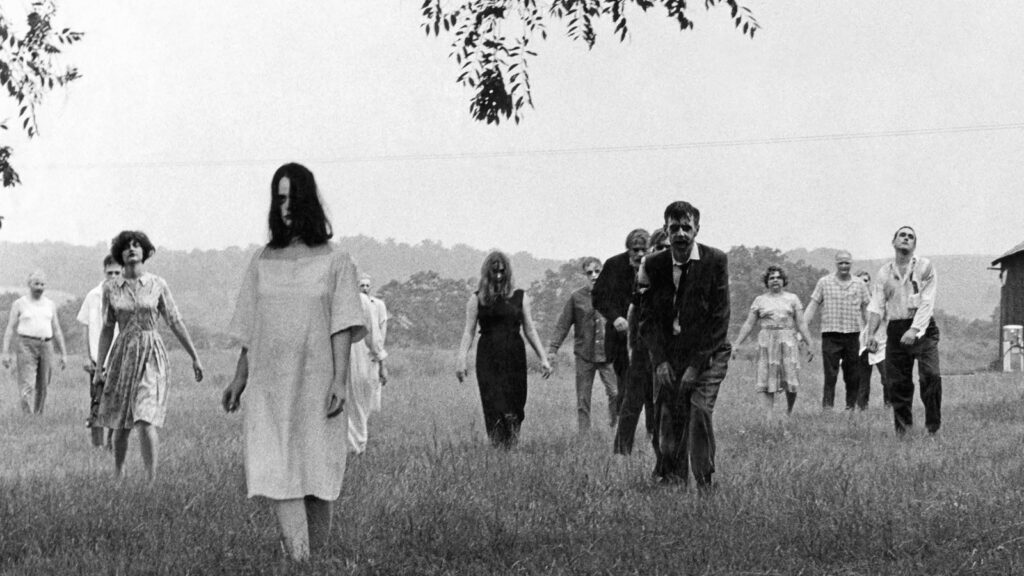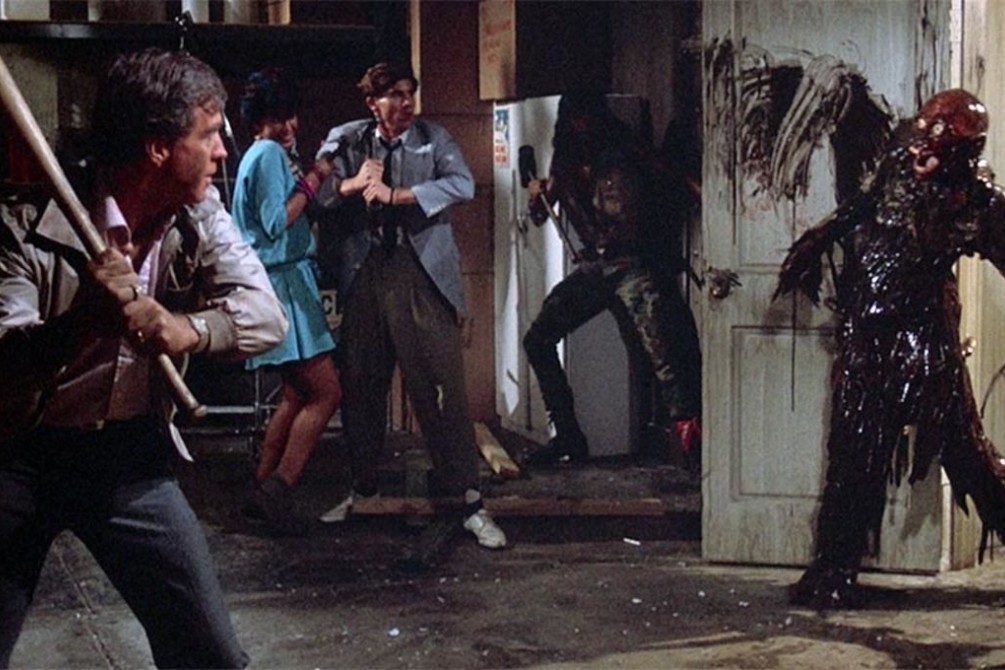Welcome to the zombie virus workshop! I created this guide for fiction writers who want to build a story around a zombie virus or similar disease outbreak.
Here’s what you’ll find in this guide:
- Zombie virus examples from books and movies
- Some original ideas we haven’t seen before
- Virus facts that fiction writers need to know
- A mini-glossary of epidemiology terms
We’ll get started in just a second. I seem to have a weird pain in my neck…
Zombie Viruses We’ve Seen Over the Years
In pop culture, zombie viruses can emerge from a variety of causes, ranging from viruses to fungi to sound waves. Here are some of the most common variations found in books, TV shows, and movies.
1. Viral Infection (Lab Accident or Bioengineering)
Example: 28 Days Later, Resident Evil series

The premise: A human-made virus spreads uncontrollably. Maybe it leaked from a lab. Or maybe somebody dispersed it intentionally, as a bioweapon. Either way, it wreaks havoc on the populace and results in a full-scale apocalyptic scenario.
Why it works: This model plays on our fears of “science gone wrong,” bioengineering, and the unintended consequences of human experimentation.
2. Radiation or Space Contamination
Example: Night of the Living Dead (1968)

The premise: Contamination from space—attached to a returning astronaut, space probe, or satellite—causes the dead to reanimate. As a side effect, they also crave human flesh.
Why it works: This model taps into a universal fear of the unknown and the inherent dangers that come with exploration. It also gives a fiction writer room for invention, because a zombie virus from space might work differently from the earthbound viruses we’re all familiar with.
3. Fungus or Parasitic Infection

Example: The Last of Us (2013), The Girl with All the Gifts (2014)
The premise: A parasitic fungus or infection hijacks the host’s body and brain, turning them into a zombie-like creature. These parasites might already exist in nature, unknown to humans, and later mutate to infect them.
Why it works: This zombie virus premise draws from real-world biology to create an organism that can control or manipulate the behavior of its host. This concept is grounded in science, which makes it feel more authentic—and more horrifying.
4. Mystical or Supernatural Curse
Example: Pet Sematary (1983), Evil Dead series

The premise: An ancient curse, ritual, or spell causes the dead to rise and walk again, with harrowing consequences. These stories often spring from mysticism and black magic, giving the dead supernatural powers and malevolent intent.
Why it works: While technically not an infectious virus, this concept allows writers to create undead zombie-like characters with supernatural powers. It provides a blank slate and allows for exploration. If you want to create an original kind of zombie virus or outbreak, consider using supernatural origins.
5. Government Experiment or Military Weapon
Example: The Crazies (2010)
The premise: A military experiment or weapon goes awry, due to a botched experiment or mishandling. Basically, the government screws up somehow and unleashes hell upon an unsuspecting populace. The virus or weapon infects people, turning them into zombies or zombie-like maniacs.
Why it works: This widely used trope explores themes of government secrecy, abuse of power, and the potential for military technology to go out of control. So it’s initially grounded in realism. It might also add some (ideally subtle) social commentary about the dangers of unchecked authority.
6. Alien Origin or Extraterrestrial Infection
Example: Night of the Creeps (1986), Plan 9 from Outer Space (1959)
The premise: Alien lifeforms or organisms infect humans and turn them into zombies, maniacs, or mindless killers. The zombie-like virus might originate from spores, alien parasites, or even a deliberate invasion strategy.
Why it works: The idea of extraterrestrial life fills us with equal parts fascination and dread—especially when those lifeforms are hostile. This story idea uses the mysteries of space to conjure something new and frightening.
7. Pollution and Toxic Waste
Example: The Return of the Living Dead (1985)

The premise: Pollution or toxic waste triggers the rise of zombies, leading to a flesh-eating chain reaction. Chemicals or biological agents released into the environment cause strange mutations, reanimation of corpses, or infections that transform the living into the undead.
Why it works: This idea uses the zombie outbreak as a metaphor for environmental pollution and degradation, a timeless concern. It reflects our deep-seated fears about the environmental consequences of human activity—and stupidity.
8. Miscellaneous (Anything You Can Imagine)
Example: Pontypool (2008)
The premise: An imaginative fiction writer could devise new ideas for a zombie virus, a mind-control pathogen, or some other trigger that transforms humans. In the 2008 film Pontypool (based on a novel by Tony Burgess) the virus spreads through spoken language, causing people to repeat words and phrases obsessively until they turn violent.
Why it works: Novels like Birdbox and movies like Pontypool offer a fresh twist on the murderous maniac theme, which closely parallels the zombie outbreak scenario. This kind of originality can help a story break apart from the pack and garner some much-deserved attention. So ask yourself, what’s a zombie virus origin story or idea we haven’t seen yet?
Original Ideas We Haven’t Seen Before
We just reviewed some of the ways fiction writers have created zombie viruses in the past. Now, let’s shift our gaze to the future, with some less-explored ideas for a zombie-like outbreak scenario. Here are some concepts we haven’t seen a lot of…
Environmental Disruption
- Climate change: Rising temperatures or changing environmental conditions cause a virus or parasite to emerge from a long period of dormancy.
- Natural disasters: An earthquake, volcanic eruption, or meteor impact releases something into the air or brings it to the surface, where it comes in contact with humans.
- Biotoxin Release: A dormant biotoxin buried deep within the Earth is accidentally released during mining operations, leading to widespread infection and zombification.
- Ocean Acidification: As ocean acidity increases, a previously harmless marine parasite adapts to infect humans, causing them to transform.
- Pollution Mutation: Toxic chemical spills or excessive pollution in oceans, rivers, or forests transform a common virus or bacteria into a new and devastating pathogen.
Technology Gone Awry
- Nanotechnology: A malfunctioning or misused nanotechnology device turns humans into mindless but violent zombie-like beings.
- Artificial intelligence: A sentient, rogue AI creates a zombie virus to eliminate humanity, which it views as its biggest adversary.
- Genetic Engineering: A genetic engineering experiment goes horribly wrong, creating a hybrid virus that transforms humans into monstrous, undead creatures.
- Bioware Malfunction: In a future where humans enhance their bodies with biotech implants, a software glitch leads to widespread brain degradation. A cyberpunk twist on the zombie genre.
Psychological Upheaval
- Collective consciousness: A mass hysteria or collective delusion turns people into mindless maniacs.
- Mind control: A virus or parasite invades the brain, causing people to lose their free will and become mindless followers.
- Social Mania: A malicious algorithm on a popular social media platform manipulates users’ emotions and beliefs, leading to a widespread outbreak of violent behavior that mimics zombification.
- Neurotransmitter Imbalance: A widespread deficiency in essential neurotransmitters with an unknown cause disrupts brain function and leads to aggressive behavior.
- Fear-Induced Psychosis: A global pandemic causes widespread fear. A fear-based virus exploits this anxiety, latching onto human consciousness. The infected are driven by paranoia, lashing out violently at all perceived threats.
Otherworldly or Supernatural
- Dimensional rifts: A virus or parasite enters our dimension through a rift or portal.
- Alien Virus: A mysterious extraterrestrial object crashes to Earth, bringing a microscopic invader along with it.
- Necromantic Plague: An ancient cult of necromancers inadvertently releases a plague from a cursed relic.
- Alien Experimentation: Extraterrestrial beings conduct experiments on Earth that involve biological manipulation.
With some research, forethought, and imagination, you could come up with an original idea that steers the zombie genre in an entirely new direction.
5 Virus Facts That Zombie Writers Should Know
In order to create a realistic zombie story, you have to understand how viruses and other pathogens work. And it’s probably best to keep it simple. You don’t have to read medical textbooks. You just need to know enough to create a plausible outbreak scenario.
Here are some key facts about viruses and pathogens to keep in mind:
- Viruses aren’t truly alive. Unlike bacteria, viruses aren’t considered living organisms. They need a host to replicate, which is why they infect cells.
- Some viruses can cross species. Viruses like Ebola and HIV originated in animals before jumping to humans. This concept (called “zoonosis”) could inspire a story where the virus comes from an unexpected source.
- Transmission types vary. Some viruses spread through respiratory droplets (like COVID), while others need direct contact with bodily fluids (like Ebola) or vectors like mosquitoes (Zika). You’ll need to consider the mode of transmission when creating a new zombie virus scenario.
- Viruses can mutate. Some viruses mutate or change rapidly, while others remain stable for longer periods of time. Mutations can make a virus harder to fight or alter its symptoms. It also gives writers a way to create subplots or twists within a zombie story.
- Incubation periods matter. The time between infection and the appearance of symptoms varies. For example, rabies can take months to show symptoms, giving infected people a false sense of security. A faster incubation period, on the other hand, could lead to a more frenetic story or plot.
Where to Find More Information
You can learn more about these and related concepts through the following resources:
- The Centers for Disease Control and Prevention (CDC) website
- The World Health Organization (WHO) website
- PubMed and Google Scholar
- Books on Virology and Epidemiology
- Books like Spillover by David Quammen, or The Hot Zone by Richard Preston
- Documentaries like Pandemic: How to Prevent an Outbreak (Netflix), and Virus Hunters (National Geographic)
- Websites like Nature.com, Science.org, and TheLancet.com
And here are some curated articles worth reading:
- What are viruses and how do they work? (Tufts University)
- How infection works (National Institutes of Health)
- All about zoonotic diseases (Centers for Disease Control)
- Could gene editing be used as a weapon (Brunel University London)
- Dormant viruses in permafrost (New Microbes and New Infections)
A Mini-Glossary of Epidemiology Terms
If you’re going to write a zombie story (or any story that involves a viral outbreak or infection), you need to grasp some basic scientific concepts. This knowledge will help you create a more realistic and believable outbreak scenario.
The following list of terms is a good place to start.
Epidemiology terms writers need to know:
- Asymptomatic: When a person is infected with a virus but doesn’t show any symptoms.
- Carrier: A person who is infected with a disease but does not show symptoms.
- Herd Immunity: When a large percentage of the population becomes immune to a virus, reducing its spread.
- Incubation Period: The time between exposure to the virus and the onset of symptoms.
- Lockdown: A policy of restricting movement and activity to contain the spread of a disease.
- Mutation: A change in the genetic material of a virus, which can affect its transmissibility, severity, or ability to evade the immune system.
- Pathogen: Any organism that causes disease, including viruses, bacteria, fungi, or parasites.
- Patient Zero: The first person known to be infected with a virus in an outbreak.
- Pandemic: An outbreak of a disease that occurs across multiple countries or continents.
- Propagation: The spread or transmission of a disease over time.
- Quarantine: Restricting the movement of people who may have been exposed to a virus, to prevent its spread.
- R0 (pronounced “R naught”): A measurement of how contagious a virus is, representing the average number of people one infected person will infect in a susceptible population. A higher R0 indicates a more contagious disease.
- Transmission: The method by which a pathogen spreads from one host to another (e.g., airborne, contact, vector-borne).
- Vaccine: A biological preparation that provides immunity against a specific disease.
- Vector: A living organism (like a mosquito or tick) that transmits a virus between hosts.
- Zoonosis: The process by which a virus is transmitted from animals to humans.
In addition to creating realism, these concepts will give you more ideas and options when it comes to developing your story.
For example, you could use the incubation period or asymptomatic carriers to create suspense in a zombie-style story. Maybe the characters don’t even know they’re infected—until it’s too late.
